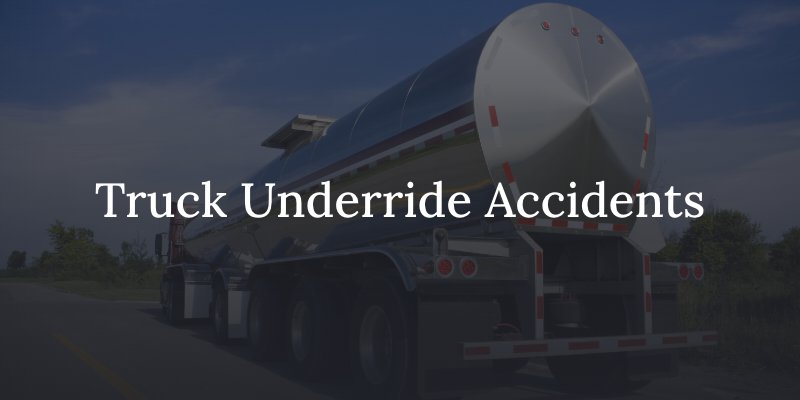Truck accidents are terrifying and traumatic. When an 80,000-pound, fully loaded 18-wheeler and a 4,000-pound passenger car collide, the motorists in the smaller vehicle are vulnerable to severe injuries. The most catastrophic accidents involving passenger vehicles and large commercial trucks are underride accidents. Underride accidents remain underreported according to the National Highway Traffic Safety Administration (NHTSA), but available data shows as many as 460 fatalities and over 2,000 injuries in truck underride accidents between 2004 and 2015. These accidents are deadly and avoidable, yet they devastate the lives of many accident victims and their families each year in the United States.

What is an Underride Truck Accident?
Underride accidents occur when a smaller vehicle slides beneath the body or trailer of a large commercial truck. Because commercial trucks ride high off the road at heights significantly higher than average passenger vehicles, their bumpers do not align with those of standard cars. They also have high tires with large gaps and raised side frames. Unfortunately, the high design of commercial tractor-trailer trucks causes three types of underride accidents:
- Rear underride accidents: this type of crash occurs when a smaller vehicle hits the rear of a truck and slides underneath during the impact. Rear underride accidents happen when a car follows a truck too closely or when a truck abruptly slows or stops and a driver cannot brake in time to avoid a collision. Defective truck taillights contribute to a substantial number of rear underride accidents. Distracted driving sometimes causes rear underride accidents when a motorist following a truck takes their eyes off the road to read or answer a text and fails to see a truck slowing or stopping in front of them. Rear underride accidents sometimes occur when a moving vehicle strikes a parked truck on the shoulder of the road. Inclement weather conditions also contribute to rear underride accidents when a slippery road causes a following vehicle to slide under the trailer of a truck. Rear underside guards prevent some underride accidents but are not present on all trucks on the roadways.
- Side underride accidents: in side underride accidents, a car crashes into the side of a truck or its trailer and becomes wedged underneath. These accidents sometimes occur in intersections, as a truck makes a U-turn, or when a truck merges onto a roadway without seeing a smaller vehicle in the lane. Truck trailers are often poorly lit, making visibility difficult at night. If a driver crossing an intersection cannot see a trailer present in the intersection they can accidentally drive into it and under it.
- Front underride accidents: these crashes occur when a truck drives over a smaller car. This happens when the truck driver follows too closely and fails to stop when the front vehicle slows or stops, or due to a truck driver’s distracted driving. They may also result from slippery road conditions or truck brake system malfunctions.
When a car slides under the body of a truck or under its trailer, injuries are almost always severe or even catastrophic to the driver and passengers in the car. Underride accidents occur most often at night or when the sun is at low angles in the sky causing less contrast between the trailer of the truck and its surroundings.
Injuries in Underride Truck Accidents
When underride accidents occur, the outcomes for motorists in the smaller vehicle are traumatic. As the front end of the car becomes wedged beneath the truck, the roof of the car crushes downward causing severe head injuries, traumatic brain injuries, and neck injuries—sometimes with spinal cord damage to those in the car. Decapitations occur in extreme cases, especially when the smaller vehicle is traveling at full speed. At high speeds, the crash force on the head, neck, and upper body of motorists is tremendous as the front of the vehicle lodges under the truck. Because the impact occurs at the windshield level of the smaller vehicle, often the airbags in the vehicle don’t deploy, increasing the likelihood of severe injuries, especially to those in the front seats.
Injuries in underride truck accidents are almost always far more deadly to motorists in the smaller vehicle that lodges below the truck while the truck driver rarely sustains injuries. The height of the truck cab keeps drivers out of the direct line of impact in underride accidents.
Rear Safety Guard Requirements for Tractor Trailer Trucks
The U.S. Department of Transportation requires rear safety bars known as underride guards on the backs of semi-tractor-trailer trucks. This safety requirement has been in place since 1998 but doesn’t include guards for the sides of commercial trucks. Also, some types of large commercial trucks are exempt from the requirement, including single-unit trucks in which the cab and cargo area are on a single chassis. Large box trucks, garbage trucks, dump trucks, oil delivery trucks, and some trucks with rear tires in the far back are also exempt, as are many agricultural and logging trucks.
Sadly, studies show that rear guards sometimes fail to protect against underride accidents. The NHTSA has been pushing for upgrades to current safety guard designs, similar to those in popular use in Canada since 2007. Many newer model tractor-trailer trucks in the U.S. already include upgraded underride guards with improved safety, but older models still fill the roadways in states across the U.S.
Some European countries already require front-end underride guards as well as rear guards.
Liability in Truck Underride Accidents
Determining who is liable for damages in a truck underride accident can be complicated. In rear-end collisions, the motorist in the rear is typically presumed to be the negligent party, but in some cases, the trucker or the trucking company may be liable. Liable parties in underride accidents may include the following:
- The trucker
- A trucking company that failed to install underride guards properly
- A truck maintenance company if they failed to properly maintain tail lights on tractor-trailers
- The manufacturer of a defective truck part
- The driver of the passenger vehicle if they committed an act of negligence or recklessness
- A third-party driver
It takes a thorough investigation of all aspects of an underride accident in order to determine who is at fault and who is liable for damages in underride truck accidents. Our St. Louis truck accident lawyer can handle these complex cases.

